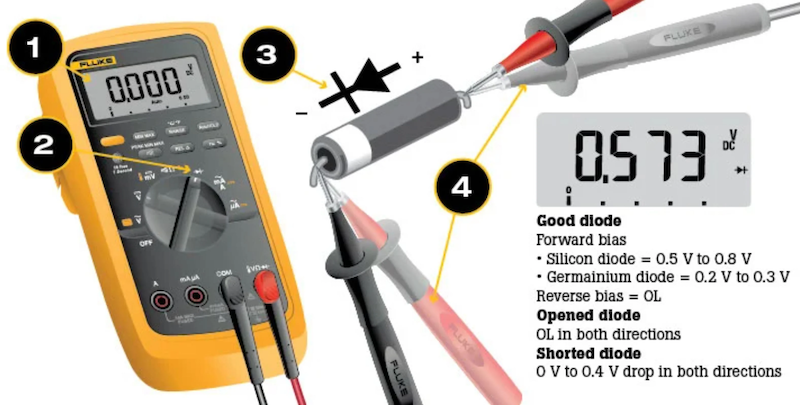Many digital multimeters, including the ELVIS DMM, can test diodes and measure their forward voltage drop. In some cases it may be necessary to remove one end of the diode from the circuit in order to test the diode. A diode is tested by measuring the voltage drop across the diode when it is forward-biased. A forward-biased diode acts as a closed switch, permitting current to flow.

A multimeter’s Diode Test mode produces a small voltage between test leads. The multimeter then displays the voltage drop when the test leads are connected across a diode when forward-biased. The Diode Test procedure is conducted as follows:
- Make certain a) all power to the circuit is OFF and b) no voltage exists at the diode. Voltage may be present in the circuit due to charged capacitors. If so, the capacitors need to be discharged. Set the multimeter to measure ac or dc voltage as required.
- Turn the dial (rotary switch) to Diode Test mode. It may share a space on the dial with another function.
- Connect the test leads to the diode. Record the measurement displayed.
- Reverse the test leads. Record the measurement displayed.
Diode test analysis
- A good forward-based diode displays a voltage drop ranging from 0.5 to 0.8 volts for the most commonly used silicon diodes. Some germanium diodes have a voltage drop ranging from 0.2 to 0.3 V.
- The multimeter displays OL (for overload) when a good diode is reverse-biased. The OL reading indicates the diode is functioning as an open switch.
- A bad (opened) diode does not allow current to flow in either direction. A multimeter will display OL in both directions when the diode is opened. The ELVISmx DMM displays the word OPEN.
- A shorted diode has the same voltage drop reading (approximately 0.4 V) in both directions.
Measuring the IV curve for a Diode
The NI ELVISmx Instrument named Two Wire Current Voltage Analyzer will perform a current versus voltage measurement for a two wire component such as a resistor or diode. To use this instrument you should connect the diode to the DUT- and DUT+ pins on the ELVIS II.


